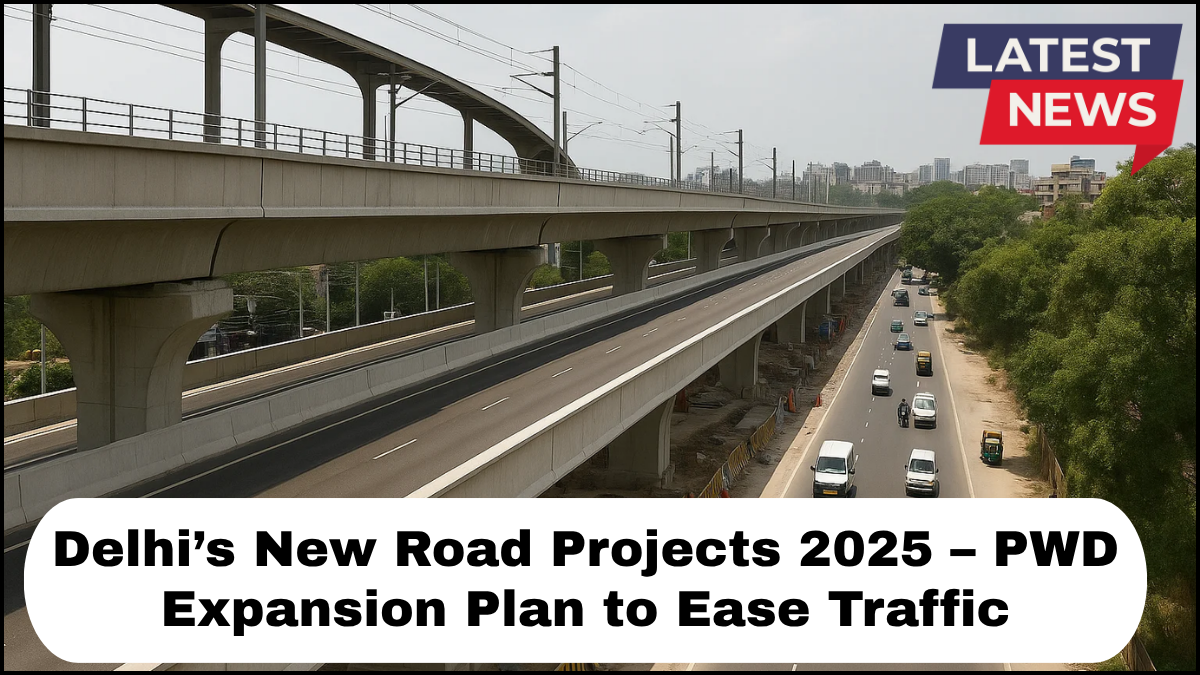Delhi’s traffic congestion is a chronic issue, with over 12 million registered vehicles navigating a road network that often feels overstretched. To combat this growing problem, the Public Works Department (PWD) has rolled out an ambitious New Road Projects Delhi 2025 initiative. This roadmap to urban decongestion includes building new roads, widening existing ones, and constructing flyovers and underpasses to reduce choke points across the capital.

Here’s a deep dive into the PWD’s multi-pronged strategy and how it aims to transform road infrastructure by 2025.
New Corridors and Road Extensions: Key Highlights
One of the biggest components of the New Road Projects Delhi 2025 plan is the creation of new arterial corridors. These include:
-
Urban Extension Road (UER-II): Spanning nearly 75 km, UER-II is designed to function as a third ring road for Delhi. Once completed, it will link NH-1 (GT Karnal Road), NH-10 (Rohtak Road), NH-8 (Gurugram Expressway), and NH-2 (Mathura Road), diverting heavy traffic away from central zones.
-
Barapullah Phase III Extension: This elevated corridor will connect Mayur Vihar in East Delhi to Sarai Kale Khan, streamlining access to South and Central Delhi. It is expected to significantly reduce travel time during peak hours.
-
Dwarka Expressway Links: While the main expressway is under NHAI, the PWD is executing feeder roads and parallel service lanes to ease pressure on adjoining sectors and improve last-mile connectivity.
These strategic road links will not only ease daily commutes but also support the city’s long-term transport infrastructure by reducing dependency on a few overburdened roads.
PWD Delhi Road Expansion: Widening for Relief
The PWD Delhi road expansion initiative goes beyond new roads. Many existing stretches are being widened to accommodate increased vehicle flow:
-
Wazirabad Road Widening: This key arterial road connecting East Delhi to North Delhi is being expanded from 4 lanes to 6 lanes. It’s expected to ease traffic bottlenecks that currently plague the region.
-
NH-24 to Ashram Corridor Expansion: As part of decongesting the stretch connecting Noida to Central Delhi, the PWD is expanding the road around Ashram Chowk—one of the city’s most congested points.
-
Outer Ring Road Widening (select stretches): Selective widening of the Outer Ring Road is planned to improve traffic fluidity in high-pressure zones like Vikaspuri, Janakpuri, and Naraina.
These expansion efforts aim to improve peak-hour traffic movement, reduce vehicular idling, and improve air quality by cutting emissions from stationary cars.
Focus on Flyovers, Underpasses & Smart Design
The PWD’s 2025 road strategy isn’t just about asphalt—it’s about smart engineering:
-
Signal-Free Corridors: New flyovers and underpasses are being built to create uninterrupted traffic corridors. For instance, the under-construction Punjabi Bagh Underpass and Shalimar Bagh Flyover will ensure seamless flow on the Ring Road.
-
Multi-level Intersections: PWD is introducing multi-level crossings at critical junctions like Anand Vihar and Bhalswa to segregate local and through traffic.
-
Integration with Public Transport: Roads under the New Road Projects Delhi 2025 are being designed with dedicated bus lanes and integration with Metro stations to ensure multimodal connectivity.
These features aim to future-proof Delhi’s road infrastructure and accommodate not only current traffic but also the projected growth over the next decade.
Budget & Timeline
The total projected outlay for New Road Projects Delhi 2025 is estimated at ₹9,500 crore. Over 60% of the projects are already under construction, with completion targets set between late 2025 and early 2026. The Delhi Government has also partnered with private contractors under EPC (Engineering, Procurement & Construction) models to accelerate execution.
Technology & Monitoring
To ensure timely delivery and quality, the PWD is using:
-
Real-time project monitoring systems
-
Drones for site surveillance
-
3D modeling for design accuracy
-
AI-based traffic flow simulations
These innovations reflect a shift in how urban road projects are conceptualized, monitored, and implemented.
Impact: What This Means for Delhiites
Once completed, the PWD Delhi road expansion and associated projects will:
-
Cut average commute times by 25-40% on key routes
-
Reduce vehicle emissions by minimizing idling at signals
-
Improve road safety through better lighting, signage, and lane demarcation
-
Boost last-mile public transport integration
For residents, daily commuters, and logistics operators, this could mark a turning point in how they navigate the city.
FAQs
Q1. What are the major projects under New Road Projects Delhi 2025?
The key projects include UER-II (third ring road), Barapullah Phase III extension, Wazirabad Road widening, and new flyovers at Shalimar Bagh and Punjabi Bagh.
Q2. When will these road projects be completed?
Most of the projects are targeted for completion by the end of 2025, with some extending into early 2026.
Q3. Will these projects ease Delhi’s traffic congestion?
Yes, the integrated approach involving new roads, widened corridors, flyovers, and underpasses aims to significantly reduce congestion and improve overall mobility.
Q4. Are any green or sustainable practices being followed in construction?
Yes, the PWD is incorporating recycled construction materials, solar-powered lighting, and rainwater harvesting in several road projects.
Q5. How can citizens track progress on these projects?
The PWD Delhi website provides updates, and selected projects are tracked through public dashboards or RTI responses.
click here to learn more